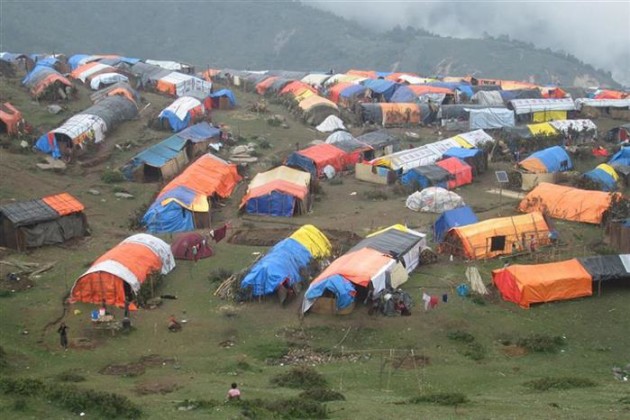2072 BS – A mixed bag of pain and pleasure (Commentary)
 Krishna Sapkota (Kathmandu) / April 13: The Year 2072 BS has left lasting memories among the Nepali denizens with a blend of pain and pleasure. Never-ever imagined physical devastation and psychological wreckage of the 25 April 2015 (Baisakh 12) Earthquake inflicted excruciating pain whereas the hard-earned promulgation of the new constitution of Nepal gave a little respite to the battered hearts and minds of the forbearing people.
Krishna Sapkota (Kathmandu) / April 13: The Year 2072 BS has left lasting memories among the Nepali denizens with a blend of pain and pleasure. Never-ever imagined physical devastation and psychological wreckage of the 25 April 2015 (Baisakh 12) Earthquake inflicted excruciating pain whereas the hard-earned promulgation of the new constitution of Nepal gave a little respite to the battered hearts and minds of the forbearing people.
The year will go down in the history books mainly for three things – promulgation of an inclusive federal democratic republic constitution, the 7.6-Richter scale devastating Gorkha Earthquake resulting in deaths and destructions and the unofficial Indian blockade disrupting supply of essential goods to Nepali territory.
The quake has left nearly 9,000 people dead, around 22,000 injured and property worth around Rs 670 billion damaged with a toll on cultural heritages, modern buildings and towers, culture, and tourism sector. It has also undermined the hard-earned development achievements and inflicted the country’s plan to graduate from the Least Developed Country (LDC) to the status of developing country. The abrupt fall of economic growth rate from around 5 per cent to 0.5 per cent now has shattered our dream for graduation into the better status.
As per the Asian Development Outlook 2016 made public by the Asian Development Bank (ADB), growth in gross domestic product (GDP) fell to 3.0% in FY2015 (ended 15 July 2015) from 5.1% a year earlier after earthquakes in April and May 2015 caused extensive damage to homes and other infrastructure and caused transport and supply disruptions. Growth in services, which account for over half of GDP, slowed to 3.9%, the lowest since 2012, as wholesale and retail trade, transport, tourism, and financial services were disrupted. Expansion in agriculture, which suffered earlier from an unfavorable monsoon, slowed to 1.9%. Persistent supply-side constraints, especially power shortages, held back growth in industry to a lackluster 2.6%.
The unofficial border blockade imposed by the southern neighbor, India, in a covert apprehension of the proclamation of Nepal’s constitution, dashed our hope to recuperate the bruises of heartrending natural disaster. The sudden disruption of essential goods and services including fuel and medicines gave a huge blow to people’s day-to-day livelihood and put Nepal on economic regression. More importantly, the uncanny gesture shook the foundation of time-tested relations between Nepal and India. The constitution came with no strings attached as Nepal subverted the time-honored hegemonic relationship with India in delivering the main law of the land and independently determining the fate of the country and its people.
Situation turned panicky when the southern plains of the country remained tense with sporadic incidents of brutalities and atrocities in the aftermath of constitution promulgation. The peaceful struggle for asserting their rights in the new constitution has not found outlet with the failure to explore win-win situation.
Lives of general public have not yet come to normalcy despite the lifting of unannounced blockade.
Though the earthquake was a devastation manifold affecting multiple areas it had enabled an environment for key political stakeholders to act and deliver the long-cherished and much-awaited constitution. It seems that the disaster prompted the political leaders to find a meeting point that leads to the delivery of the statute through the second Constituent Assembly (CA) election. Almost 90 per cent of the democratically elected people’s representatives in the CA endorsed the constitution ending a protracted transition and political quagmire.
The Nepali Congress President Sushil Koirala-led government materialized its bid to give country a new constitution in a coordinated and collaborated efforts with key stakeholders including political parties and state organs. Then President Dr Ram Baran Yadav put his signature on the Constitution of Nepal, marking the commencement of the statute amid a grand ceremony. “I hereby announce commencement of new constitution which was endorsed by CA and authenticated by Constituent Assembly Chair on September 20, 2015,” President Yadav said in his address to the CA and the nation. CA Chair Subas Nembang’s role in regard to the framing and promulgating of the new constitution was very crucial.
Nevertheless, the euphoria of the achievement after a long sabre-rattling between different political interests and ideologies in the country did not last long with Madhes unrest and unwelcoming gesture of the neighbor. The Madhes-based parties are still on agitation demanding more rights and review in the proposed boundaries of seven provinces as enshrined in the new constitution.
The year-2072 has tested the strength of Nepal and Nepali people to restrain patience and tolerance in the grief-stricken moment. Let us review and learn lessons from our blemished past of 2072 and salute to the dawn of 2073 BS with hope that things will go good. ‘For yesterday is but a dream. And tomorrow is only a vision. But today well-lived makes every yesterday a dream of happiness.’ The remarkable lines of the poem by Sanskrit Poet Kalidasa are an apt reference to learn lessons from the past and work towards a beautiful present for tomorrow. RSS
